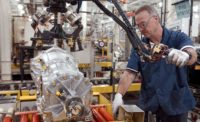Numerous pundits have forecast that U.S. manufacturing will follow the path of agriculture: Automation will replace human workers and steal all of our jobs. It will be an automation doomsday. Clearly, returning jobs will be, on average, higher skilled and fewer in number than when the work was lost offshore years ago. However, in reality, automation is key to reshoring and thus to U.S. job growth.
Automation will most certainly transform jobs in manufacturing. However, the U.S. is not the only country in the world that is adopting automation. Other countries, especially China, are investing heavily in these technologies, too. Market research firm International Data Corp. reports that China’s spending on robotics will reach $59.4 billion in 2020, accounting for about 30 percent of worldwide spending on the technology.
So, we either automate, or we lose more to offshore automation than we would to domestic automation. Automation will eliminate some low- and mid-skill jobs. However, it also decreases cost and restores competitive advantage, making more reshoring possible. More reshoring and less offshoring means more manufacturing jobs.
Automation helps developed countries more than developing countries. Developing countries’ key advantage is lower wage rates. Automation reduces the labor hours required to produce goods and shifts the labor mix toward higher skilled workers. That creates a problem for China, because at higher skill levels, the wage gap between U.S. and Chinese workers is smaller. Additionally, automation can actually be more costly in China because imported machinery is subject to a value-added tax (VAT).
Balancing the trade deficit can bring jobs back faster than automation can take them away. Balancing the trade deficit will bring back 3 million to 5 million manufacturing jobs at the current level of U.S. productivity. That’s 25 to 40 percent of our current manufacturing workforce. If we increase our productivity growth rate by two percentage points per year, it would take almost 15 years to absorb the work that is now offshore. We can have productivity growth and employment growth.
The feasibility of returning large numbers of jobs is increasingly clear. In 2017, the number of U.S. manufacturing jobs created through either reshoring or foreign direct investment (FDI) surged to more than 171,000. That amounts to 90 percent of the 189,000 total manufacturing jobs added in 2017. It also brings the total number of manufacturing jobs brought to the U.S. from offshore to more than 576,000 since the employment low of 2010.
More than 350 of the companies that have reshored or invested in U.S. factories mention automation or productivity as important factors in their decision to produce or source here, according to the Reshoring Initiative’s latest data.
The Chinese ex-works price averages about 72 percent of the U.S. price, while the Chinese total cost of ownership (TCO) averages about 95 percent of the U.S. TCO. Companies source mainly on price. To bring back 2 million manufacturing jobs will require some combination of a stronger skilled workforce, lower U.S. dollar, consistent use of TCO for sourcing decisions, a VAT, and a 20 percent increase in productivity. Some jobs will be lost to productivity, but the losses will be much less than if we are unable to reshore.
Automation is not a problem; it is an answer to our biggest problems. The only solution is to automate as rapidly as is possible given economic and manpower constraints. Companies should stay focused on selling against imports based on total cost analysis and on using automation to close any remaining cost gaps. Lower tax rates and immediate expensing of capital expenditures under the new tax law make automation even more affordable. Don’t miss this opportunity!


